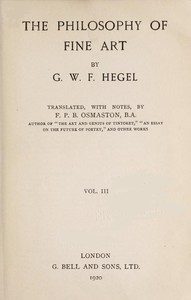The Philosophy of Fine Art, volume 3 (of 4) by Georg Wilhelm Friedrich Hegel
"The Philosophy of Fine Art, volume 3 (of 4)" by Georg Wilhelm Friedrich Hegel is a compilation of lecture notes published in 1835. This volume explores Hegel's theory of art as a manifestation of absolute spirit, tracing art's development through symbolic, classical, and romantic stages. Hegel examines five major arts—architecture, sculpture, painting, music, and poetry—in ascending order of spiritual inwardness. His lectures address art's evolving role in expressing truth and have profoundly
influenced aesthetic theory, sparking debate about art's historical transformation and cultural significance. (This is an automatically generated summary.)
Read or download for free
| How to read | Url | Size | |||
|---|---|---|---|---|---|
| Read now! | https://www.gutenberg.org/ebooks/55623.html.images | 1.2 MB | |||
| EPUB3 (E-readers incl. Send-to-Kindle) | https://www.gutenberg.org/ebooks/55623.epub3.images | 768 kB | |||
| EPUB (older E-readers) | https://www.gutenberg.org/ebooks/55623.epub.images | 784 kB | |||
| EPUB (no images, older E-readers) | https://www.gutenberg.org/ebooks/55623.epub.noimages | 486 kB | |||
| Kindle | https://www.gutenberg.org/ebooks/55623.kf8.images | 1.1 MB | |||
| older Kindles | https://www.gutenberg.org/ebooks/55623.kindle.images | 1.0 MB | |||
| Plain Text UTF-8 | https://www.gutenberg.org/ebooks/55623.txt.utf-8 | 1.0 MB | |||
| Download HTML (zip) | https://www.gutenberg.org/cache/epub/55623/pg55623-h.zip | 687 kB | |||
| There may be more files related to this item. | |||||
Similar Books
About this eBook
| Author | Hegel, Georg Wilhelm Friedrich, 1770-1831 |
|---|---|
| Translator | Osmaston, Francis Plumptre Beresford, 1857-1925 |
| Title |
The Philosophy of Fine Art, volume 3 (of 4) Hegel's Aesthetik |
| Note | Wikipedia page about this book: en.wikipedia.org/wiki/Lectures_on_Aesthetics |
| Credits |
Produced by Laura Natal Rodriguez and Marc D'Hooghe at Free Literature (online soon in an extended version,also linking to free sources for education worldwide ... MOOC's, educational materials,...) Images generously made available by the Internet Archive.) |
| Reading Level | Reading ease score: 37.0 (College-level). Difficult to read. |
| Language | English |
| LoC Class | N: Fine Arts |
| Subject | Aesthetics |
| Category | Text |
| EBook-No. | 55623 |
| Release Date | Sep 25, 2017 |
| Most Recently Updated | Oct 23, 2024 |
| Copyright Status | Public domain in the USA. |
| Downloads | 558 downloads in the last 30 days. |
| Project Gutenberg eBooks are always free! | |

